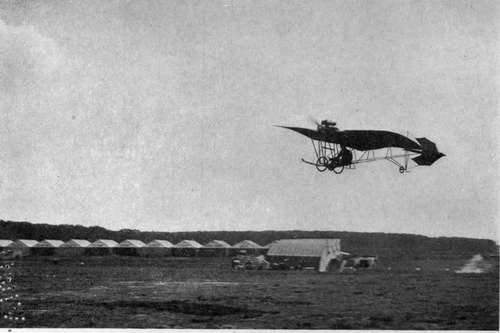Chapter XIII. Some Typical Monoplanes
Description
This section is from the book "The New Art Of Flying", by Waldemar Kaempffert. Also available from Amazon: The New Art of Flying.
Chapter XIII. Some Typical Monoplanes
Monoplanes differ less from one another than biplanes. Nearly all of them have the same system of lateral control, and the same method of mounting the motor. As a general rule this system of lateral control is the Wright wing-warping method. The motors are usually Gnome motors mounted in front of the machines.
The Antoinette Monoplane
Antoinette monoplanes (Fig. 84) are designed and built by Levavasseur, a well-known manufacturer of motors.
The single silk surface of an Antoinette monoplane is constructed in two halves which are so mounted that they form a slight dihedral angle. This plane is braced to a central mast or spar, and is carried on a girder-like frame of aluminium, cedar, and ash. The spread of the plane is 49 feet; the area 405 square feet.
The horizontal rudder is a single surface at the extreme rear of the machine and is controlled by a hand-wheel at the aviator's right (Fig. 32).
The vertical rudder comprises two surfaces at the rear of the machine. Tiller cables lead from the surfaces to a lever operated by the aviator's feet.
To balance the machine from side to side the plane is warped after the Wright principle. In contradistinction to the Wright machine, however, the front edges are flexible and the rear edges fixed. To warp the plane a hand-wheel is provided at the aviator's left.

Fig. 84. The Santos-Dumont "Demoiselle" in flight.
Photograph by Edwin Levick.
The mast, to which the plane-halves are braced, contains a pneumatic shock-absorber in its lower end, besides which there are two wheels with heavy pneumatic tires and a forward plough-like skid. A skid in the rear is used to support the tail.
On each side of the body is a horizontal, fan-shaped keel at the rear to steady the machine longitudinally. A vertical fin above this horizontal fin gives a certain amount of lateral stability.
An 8-cylinder V-type water-cooled Antoinette motor of 50 horse-power is placed in front of the machine and drives a 7-foot propeller. At the International Aviation Meeting held in 1910 at Belmont Park, Latham flew a 100 horse-power Antoinette.
The Antoinette monoplanes which are built in Germany are equipped with 100 horse-power Gnome motors of fourteen cylinders. The area of the wings can be reduced by about one square metre, the smaller area being employed when the aviator is flying alone. When three passengers are carried besides the aviator, the span can be increased to fifteen metres, so that the area amounts to four square metres. The passengers are placed symmetrically, so that the centre of gravity of the machine is not disturbed. This large Antoinette machine is somewhat longer than the normal Antoinette, built in France. Since the utilisation of the Gnome motor means the abandonment of the usual Antoinette water-cooling plant, and such auxiliary apparatus as radiators, pumps, etc., it was necessary to redistribute the weight. Accordingly the German machine is longer than the French, so that the motor can be placed out further.
Continue to:
